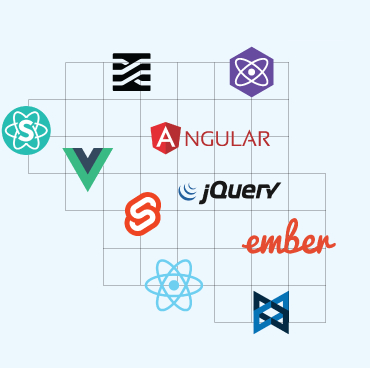Visible on Internet from any Device..
Modern web development leverages a range of technologies such as HTML5, CSS3, JavaScript, and frameworks like React, Angular, and Vue.js to build responsive and interactive websites. These technologies enable developers to create websites that are not only visually appealing but also highly functional and user-friendly, ensuring a seamless experience across different devices and browsers.
Web Development - UI & Frontend
Important aspect of Web Development

The Importance of User-Centric Design in Web Development
User experience (UX) design plays a crucial role in web development, as it focuses on the overall feel of the website and how users interact with it. By conducting user research and usability testing, we can identify pain points and areas for improvement, ensuring that the final product meets the needs and expectations of its users. This user-centric approach helps in building websites that are not only functional but also enjoyable to use, leading to higher user satisfaction and retention.
Innovative Tech Ensures Optimized and Secure Websites
Web development is an ever-evolving field that requires continuous learning and adaptation. With the rapid advancement of technology, new tools, frameworks, and best practices are constantly emerging. Cyberhut stay updated with these changes to remain competitive and deliver cutting-edge solutions. By staying informed and embracing innovation, We creates website that are not only current but also future-proof, capable of adapting to new trends and technologies as they arise.

Web Development - backend
The Backend Technologies
The back-end, or server-side, focuses on the underlying logic, database interactions, and server configurations that enable the front-end to function seamlessly.
PHP
PHP is a widely-used open-source scripting language that is especially suited for web development and can be embedded into HTML. It is known for its simplicity and flexibility, making it a popular choice for beginners and experienced developers alike. PHP powers many of the world’s websites and web applications, including popular content management systems like WordPress. Its extensive library of built-in functions and a large community of developers contribute to its robustness and versatility.
PHP’s server-side scripting capabilities allow for dynamic content generation, database interaction, and session management. It integrates seamlessly with various databases, including MySQL, PostgreSQL, and SQLite. Additionally, PHP frameworks like Laravel and Symfony provide structured and efficient ways to build complex applications, offering features like routing, authentication, and templating out of the box.
Flask
(A Python Web Framework)
Flask is a lightweight and micro web framework for Python, designed to be simple yet extensible. It provides the essentials for web development, such as routing, request handling, and templating, without imposing a specific project structure or dependencies. This flexibility makes Flask an excellent choice for small to medium-sized applications and for developers who prefer to have more control over their project’s architecture.
Flask’s modular design allows developers to choose the components they need, making it easy to integrate with various libraries and tools. It supports extensions for adding functionality like database integration, form validation, and authentication. Flask’s simplicity and ease of use, combined with Python’s readability, make it a popular choice for both beginners and experienced developers looking to build scalable web applications.Django
(A Python Web Framework)
Django is a high-level Python web framework that encourages rapid development and clean, pragmatic design. It comes with a robust set of features out of the box, including an ORM (Object-Relational Mapping) system, authentication, and an admin interface. Django’s “batteries-included” philosophy means that developers can focus on writing their application without needing to reinvent the wheel for common tasks.
Django’s emphasis on reusability and “don’t repeat yourself” (DRY) principles helps developers write efficient and maintainable code. Its powerful ORM allows for seamless database interactions, while its templating engine facilitates the creation of dynamic web pages. Django’s comprehensive documentation and active community support make it a reliable choice for building complex, data-driven web applications.
WebAssembly (WASM)
WebAssembly (Wasm) is a binary instruction format for a stack-based virtual machine, designed to be a portable compilation target for high-level languages like C, C++, Go and Rust. It enables high-performance execution of code on web browsers, providing near-native speed for web applications. Wasm is designed to complement JavaScript, allowing developers to leverage existing web technologies while achieving performance improvements.
Wasm’s ability to run code at near-native speed opens up new possibilities for web development, such as running complex algorithms, games, and simulations directly in the browser. It is also secure by design, with a sandboxed execution environment that prevents unauthorized access to the host system. Wasm’s growing support across major browsers and its integration with JavaScript make it a promising technology for the future of web development.
Express
(Node Framework)
Express is a minimal and flexible Node.js web application framework that provides a robust set of features for building web and mobile applications. It is known for its simplicity and performance, making it a popular choice for developers looking to build scalable and high-performance applications. Express provides a thin layer of fundamental web application features, without obscuring Node.js features that developers know and love.
Express’s middleware architecture allows developers to add functionality to their applications in a modular way. It supports a wide range of middleware for handling tasks like authentication, logging, and error handling. Express’s flexibility and extensive ecosystem of plugins and extensions make it a powerful tool for building RESTful APIs and single-page applications.WordPress
WordPress is a popular open-source content management system (CMS) that powers a significant portion of the web. It is built on PHP and uses a MySQL or MariaDB database. WordPress is known for its ease of use, flexibility, and extensive ecosystem of themes and plugins, which allow users to create and manage websites without needing to write code.
WordPress’s user-friendly interface and powerful customization options make it suitable for a wide range of websites, from personal blogs to large e-commerce sites. Its plugin architecture enables developers to extend its functionality, adding features like SEO optimization, social media integration, and e-commerce capabilities. WordPress’s active community and comprehensive documentation make it a reliable and accessible choice for web development.
Web Developemt - Database
Importance of Database
Databases are crucial in web development as they store, organize, and manage the vast amounts of data required for dynamic websites and applications. They enable efficient data retrieval and manipulation, ensuring a seamless user experience and robust functionality.
SQL (Structured Query Language)
SQL databases are relational databases that use structured query language for defining and manipulating data. They are known for their table-based structure, where data is organized into rows and columns, making it easy to perform complex queries and transactions. SQL databases are highly consistent and support ACID (Atomicity, Consistency, Isolation, Durability) properties, ensuring reliable transactions.
NoSQL (Not Only SQL)
NoSQL databases are designed to handle large volumes of unstructured or semi-structured data, offering flexibility and scalability that traditional SQL databases may lack. They do not rely on a fixed schema, allowing for dynamic changes to data structures without downtime. NoSQL databases are categorized into various types, including document stores, key-value stores, column-family stores, and graph databases, each optimized for different use cases.


